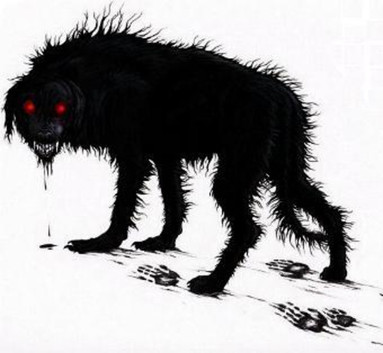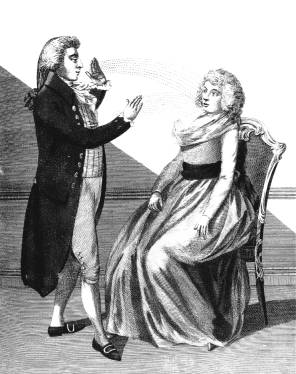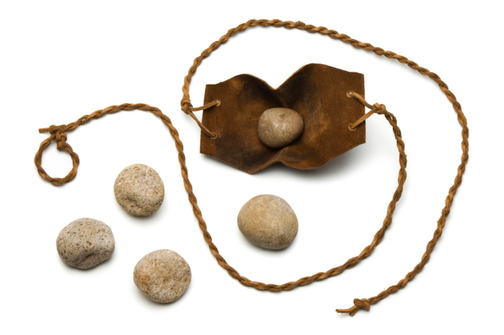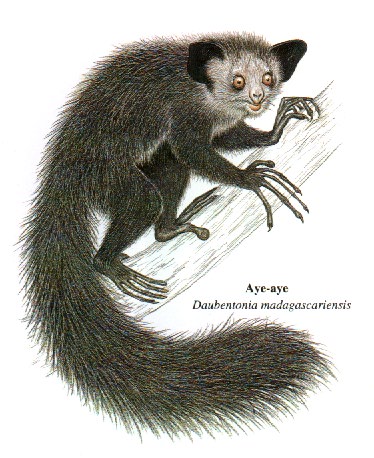~Ally
But, since he's not my favorite super hero, I didn't notice that until today. Feast yer eyes!
~Ally
0 Comments
Except for humans, apparently the most dangerous species out there is the Black Wattle or Black Acacia (Acacia mearnsii). This plant is originally from Australia, and was introduced in several parts of the globe in the 70's to recover riparian areas and as ornamentation. The results were catastrophic. The problem is that this Acacia alters the soil nutrients, generating substances that prevent the germination of the native species where it is planted. It can only be eliminated by powerful herbicides, which will also affect the other nearby plants as well, practically destroying the vegetation of the area. ~Ally
I first read about the Gytrash this week at my Jane Eyre novel by Charlotte Brontë and became quite curious about this creature. The Gytrash is a legend from northern England, a being that may take the form of a dog, a horse or a mule. It haunts lonely roads, awaiting for travelers to lead astray, for what they are much feared. They can also be benevolent, though, guiding lost travelers to the right road. It is also referred to as "Shagfoal" in some parts of Lincolnshire and Yorkshire, where the form of a spectral mule or donkey with eyes that glow like burning coals are believed to be malevolent. A nice companion to the Will-of-the-Wisps, huh? ~Ally
I thought the expression "Animal Magnetism" referred to a special kind of sexual attraction of one animal towards another. Blame Shrek's Donkey for that. Turns out that this is another name for Mesmerism or Biomagnetism, originally studied by Antoine Mesmer (1734 - 1815), which can be defined as the reciprocal action of two living beings through an intermediate, a special agent, called the magnetic fluid. This was a science well known in ancient Egypt, where it was practiced as part of religious mysteries. This science states that the human body is capable of producing magnetic fields of the order of nanoteslas (10^9 T), which can be measured and used for treatments and diagnosis. ~Ally
I remember the last time I went to the dentist and got my two lower wisdom teeth (here in Brazil we call them "sisos", a way less pretentious name, I guess) pulled off. The worst part of the whole operation was the local anesthesia (two injections, one in each side of the mouth), which was a little painful. After that, I totally relaxed - well, I got the most relaxed I could, considering they were breaking and pulling out my teeth - and didn't feel the left side of my face up until many hours later. But what about the ancient people? How the hell could they stand having their teeth pulled off, or any other surgery for that matter?! Anesthesia as we know it began to be developed in 1842, by the North American dentists Horace Wells and William Thomas Green Morton, who started to use ether and nitrous oxide (laughing gas) to knock down and/or prevent their patients from feeling pain. However, before that, medicine doctors and dentists used substances like opium, plants like henbane and mandrake, as well as wine. Assyrians used to compress the carotid of the patient until he/she passed out, then began the procedure. Hippocrates, the "father of medicine", used a soporific sponge, embedded with wine, opium, henbane and mandrake to knock out his patients, putting it under their nose. In Medieval Europe, it was common to knock down the patient with a wooden bowl. They also used magic and prays when someone needed surgery. I don't think it worked very often! Furthermore, up until the 16th century, doctors used ice and snow to freeze the parts of the patient's body before surgery. Hypnosis was also used, sometimes. Thank heavens for modern medicine! ~Ally
I had heard about 1816 and its absent summer in the Rasputina song from the video above (the music isn't complete in it, but it's a really cool video, make sure to check out the full song too!), and often wondered what was the actual consequences of that episode. Turns out that the Year Without a Summer was caused by the great amount of ash stationed in the atmosphere after the eruption of the Indonesian volcano Tambora in april 10th 1815. The sun rays couldn't get past that heavy air and, as a result, there were great snowstorms, frosts and rains in the following summer. That made survival in the Northern Hemisphere really hard. Many countries in Europe went through famine, a lot of people died because of this and also from diseases and the livestock almost didn't make it. Of course, a great part also suffered and died from the eruption itself. In Portugal and Spain, however, this "winter" was not so harsh - although many died there too -, and they were able to export cereals for the other countries, where the crops were basically destroyed by the weather. At times like these, I'm glad to be born in Brazil! ~Ally
David used one to slay the giant Golias. But slings apparently were also used in ancient wars, along with bows, swords and spears! Back in those days, the slingers - soldiers who used the slings - stood behind the spearmen and before the bowmen. They were an important line of attack in the army, causing many casualties. They practiced throwing rocks for long distances and had considerably good aim. Since the blows didn't cause mutilation or blood loss, the Roman writer Vegecius affirmed that the deaths caused by this weapon (by contusion) generated a lot of confusion in the battles. This weapon was also really useful, according to him, when occupying a stony land, defending a castle, a mountain or an elevation. ~Ally
For many years scientists - myself included - believed dogs couldn't see colors. Recent studies have shown we were wrong, fortunately! Dogs have cone cells in their eyes, just like us humans, but they have only 10% of the amount we do. Their cells are equivalent to our red cone cells (which allows us to see the color red) and blue cone cells (that allows us to see blue). However, their cells makes them see greenish yellow and violet, respectively. This results in a type of daltonism that causes dogs to confound red and green. Despite this, they're pretty good in distinguishing green from blue. If you throw a red and a blue ball in the grass, your dog will probably find the blue one easier, for example. They can also see much better than us in the dark, because of their rod cells and tapetum lucidum in the back of the eye. Awesome! ~Ally
The aye aye seems to me like a crossing between a squirrel, a bat, a monkey and a really sloppy day of creation by God (no offense!). Poor thing. Even though their looks aren't that pleasing, they're pretty cool animals! Believe it or not, these mammals are related to apes, chimpanzees and humans! They're originally from Madagascar - a place where almost everything dubious and fascinating in terms of animals can be born, from all that I've seen during college - and live in nests in treetops of rain forests, avoiding coming down to earth. Nocturnal animals, they are the only primates thought to use echolocation to find prey (like bats, told ya!), which is totally amazing! The aye-aye taps on trees with its long middle finger and listens for wood-boring insect larvae moving under the bark. It employs the same middle finger to fish them out. The digit is also useful for scooping the flesh out of coconuts and other fruits that supplement the animal's insect (and omnivore) diet. They can live up to 20 years in captivity and are considered a threatened species, and are protected by law. They have been hunted a lot in the island, since many natives believe that they're an omen of ill luck. It's so sad to know that a unique species like this still suffers from human ignorance. But, thinking again, which non-human species doesn't? ~Ally
Everybody knows the bad stories about the number 13. But what about the good ones? In Hebraic, "13" corresponds to the letter "mem", which represents rebirth and freedom. For the Jews, is also represents evolution or fate. In Numerology, it is the resumption, to begin something new. It is also the number of the organized system and of beneficial conclusion. "13" is the symbol of the specific and particular. It is considered a exception of the rule, a marginal number. Thirteen is associated with initiation. In India, "13" is considered a sacred number. In China, it is related with positive mystical things. The Mayans considered the "13" as something sacred. The American seal has an eagle sustaining a shield with 13 stripes, and also holding 13 olive branches in its right paw and 13 arrows in its left paw. The Brazilian soccer coach Zagallo always uses the "13" as his lucky number-amulet. The thirteenth Tarot card is "Death", which stands for transformation, change and renovation. ~Ally
|








 RSS Feed
RSS Feed